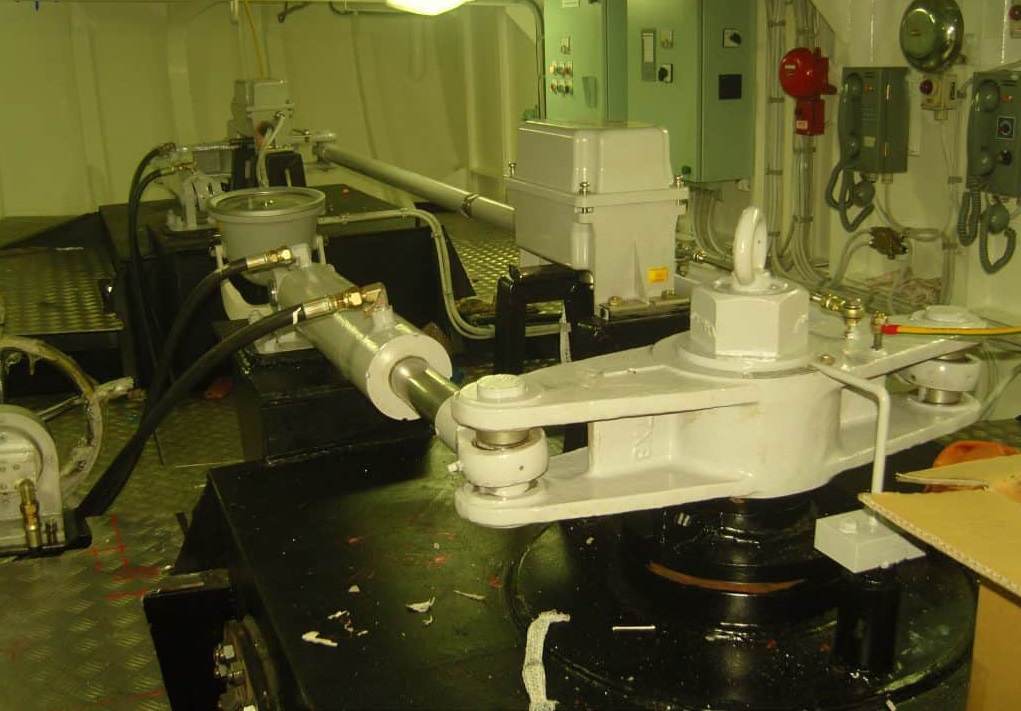A vessel, under pilotage, departed a port in ballast and was down bound in a restricted waterway. The engine control was set to bridge control and a helmsman was using manual full follow-up (FFU) steering.
At one point a port alteration was requested; however, the rudder angle indicator showed 10 degrees to starboard. Several port and starboard helm inputs were attempted with the FFU but no rudder movement could be observed on the rudder angle indicator. The pilot then ordered the engine to be stopped and that the anchor be readied.
The Master arrived on the bridge just as the vessel was leaving the buoyed channel. He went directly to the steering stand and transferred the steering system actuator switch from the port system to starboard system. This action restored control to the steering but it was too late. The vessel ran aground at an estimated speed of 8 knots over the ground.
Accidents because of steering gear failure are common in the maritime industry. Such incidents have lead to some serious accidents in the part, causing heavy damage to ship, its crew and the environment.
Periodic maintenance and checks are extremely important for smooth functioning of ship’s steering gear. However, there are a few common issues which tend to occur in spite of taking all necessary precautions.
Mentioned below are eight such common issues of steering gear system:
1. Oil Leakages: Port state controls have very strict policy of zero leakage from ship’s steering gear. Many ships have been fined and detained due to such faults pointed out during port state control inspection. Still, oil leakage from the steering gear is one of the most common problems on ships – a result of machinery systems having several moving parts operated by hydraulic oil. Some of the main areas of leakages are cylinder-ram seal in hydraulic ram type steering gear and seal in the chambers of a rotary vane pump. Needless to say, any kind of leakage from steering gear system must be rectified immediately.
2. Difference in the Actual Rudder Angle and Ordered Helm Angle: Another common problem observed in steering gear system is the difference in the angle given at the helm and the actual rudder angle. This occurs due to wrong or insufficient adjustment of control and repeat back lever. To rectify this problem, the turn buckle attached to the rod of control and repeat back lever are to be precisely adjusted.
3. Unsatisfactory Steering : The fuel consumption of the ship greatly depends on the efficiency of steering gear operation. If the steering gear is operating unsatisfactory, it will lead to delay in the ETA of the ship and increase main engine fuel consumption. Common reason for this problem is malfunctioning of safety valves or by pass valves in the system. Any problem in the control and repeat back lever will also lead to unsatisfactory steering.
To solve this issue, safety and by pass valve operation are to be checked at regular intervals. If any problem is noted, same to be recited at the earliest.
For control and repeat back lever, the turn buckle attached to the rod of control and repeat back lever are to be precisely adjusted.

4. Excessive Noise from Steering Gear: Excessive noise and vibrations from the steering gear indicates entrapment of air in the system. Due to air bubbles in the oil, pumps and pipings are subjected to air hammer leading to vibration and heavy noise. Air must be removed from the system using vent valve provided in the cylinder and pump specially after the system is replenished with new oil. If the valve located in the oil supply tank of the steering gear is throttled or closed, it will again develop air bubbles in the system. Ensure that this valve is always open when the system is in operation.
5. High Oil Temperature: Oil is the operating media in the steering gear system. Any abnormality in the parameters of oil will lead to other operations related problems in the steering gear. If there is increase in the oil temperature, it will directly reduce the viscosity of the oil and hamper the steering operation. The most common cause of increase in oil temperature is low oil level in the system. Thus, ensure that low oil level alarm in the tank is working and replenish the oil when required.
6. Rudder Movement is Within or Beyond the Limit: The SOLAS requirement for steering gear says that the system must be capable of putting the rudder over from 35 deg on one side to 35 deg on the other side of the ship at its deepest seagoing draught and running at maximum ahead service speed. It may sometimes happen that the maximum angle reached by the rudder is less than prescribed or the rudder is overshooting the 35 degree angle mark.
One of the main reasons for this problem is malfunctioning of limit switch fitted on the repeat back unit or on the auto pilot. Replace the malfunctioned limit switch or adjust the limit switch to maximum prescribed rudder angle.

7. No Steering from Remote control: Their is always a provision of local maneuvering in the steering gear for emergency situation if the remote control operation fails. Some common reasons for failure of remove controls are :
· Break down of hydraulic pumps : Other hydraulic pump to be started in such cases
· Malfunction of transfer valve
· Malfunctioning of hydraulic by pass valve in the pump
· Oil leakage
· Problem in tele control system
8. Rudder Angle Transmitter and Tiller Link Failure: On 29 April 2011, the Panama registered bulk carrier Dumun grounded while departing the port of Gladstone, Queensland. Prior to the grounding, the ship’s steering appeared to have stop responding to bridge commands when the linkage between the tiller and rudder angle transmitter detached. The steering gear continued to operate normally, but the transmitter lost its input signal and, as a result, the bridge mounted rudder angle indicator stopped working. Such cases are rare but they do occur.
To avoid such accidents, ensure that the duty officer must take a round before every maneuvering or departure port to check all the linkages in the engine room.



Comments are closed